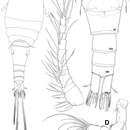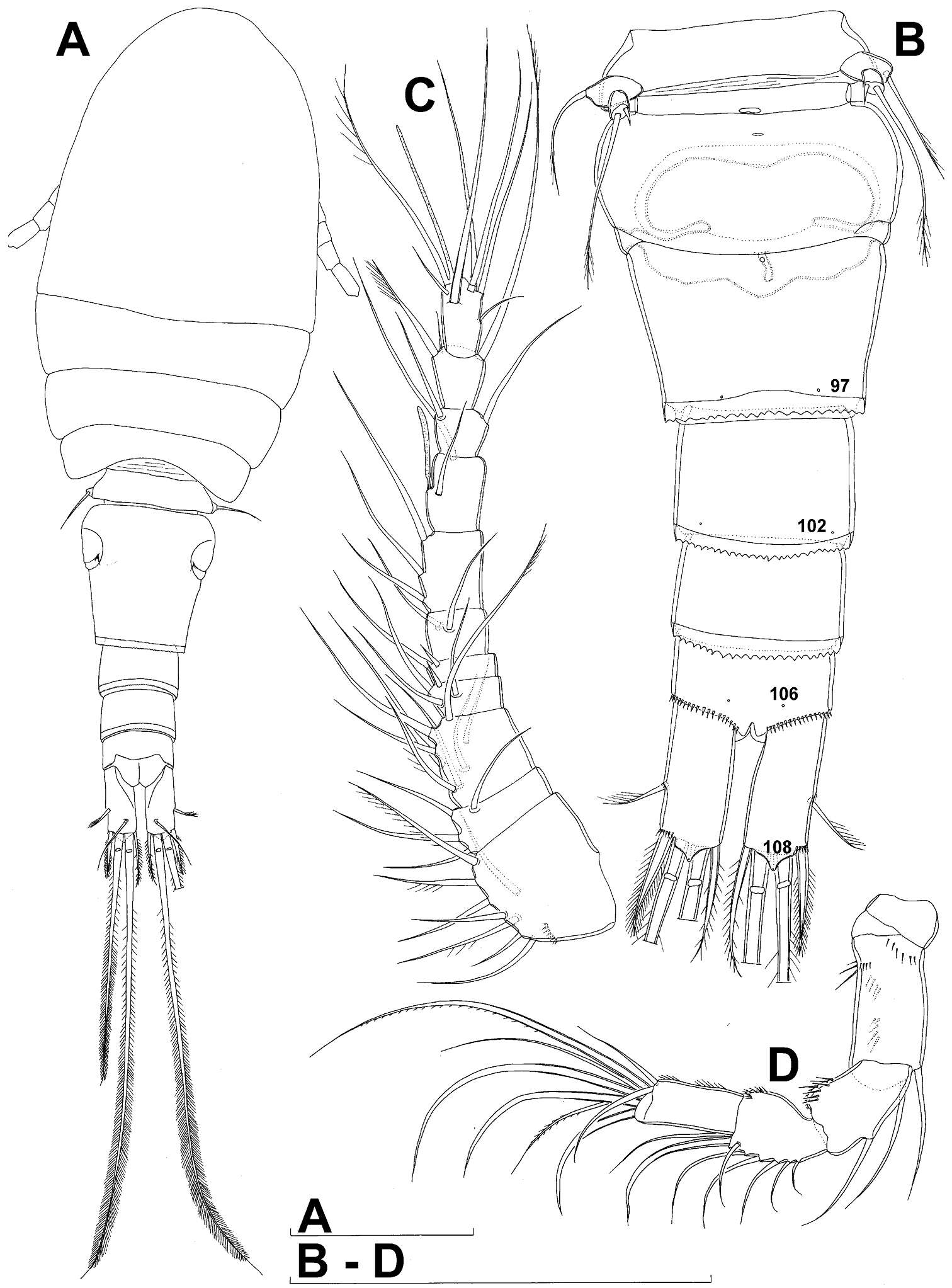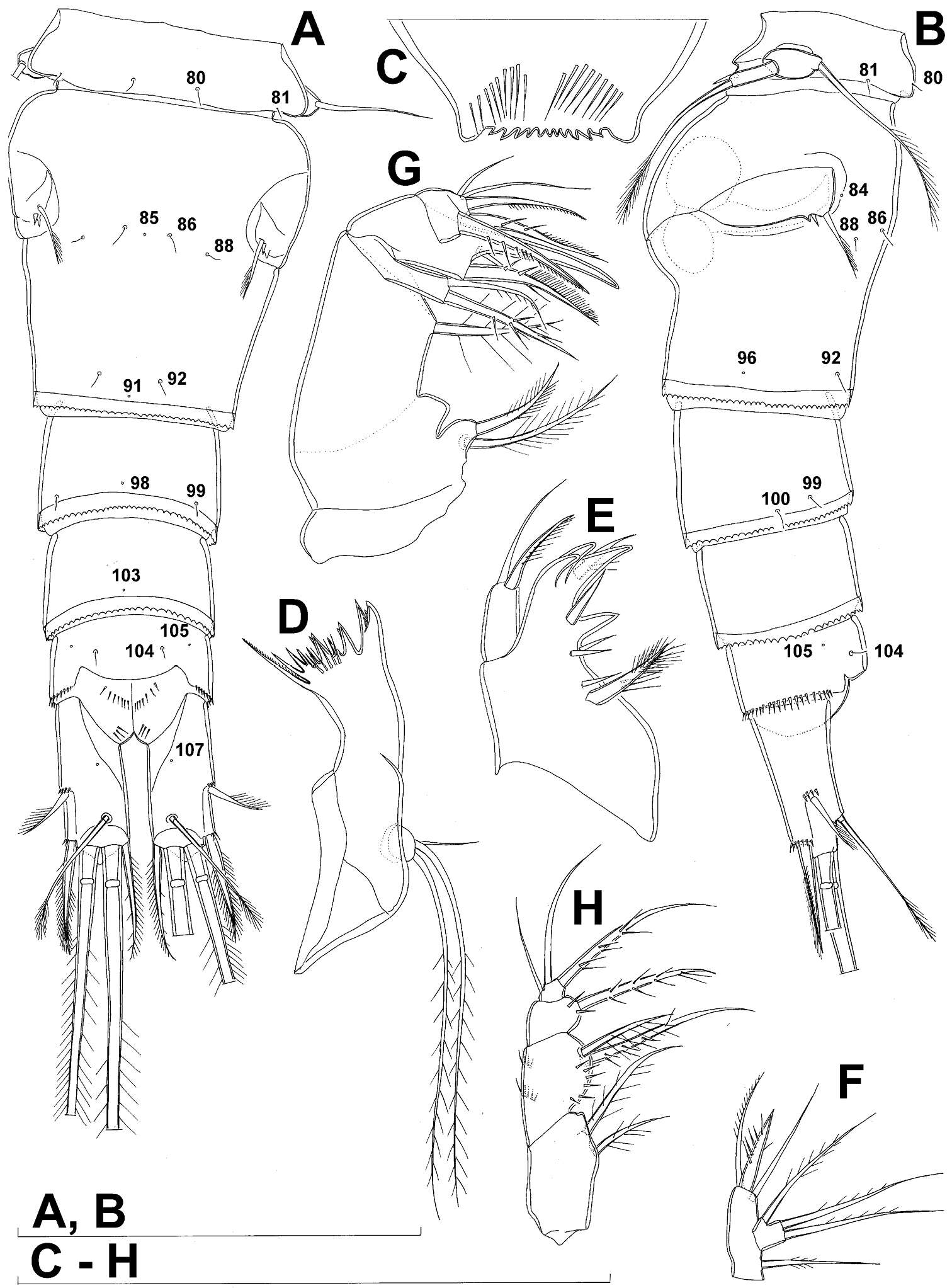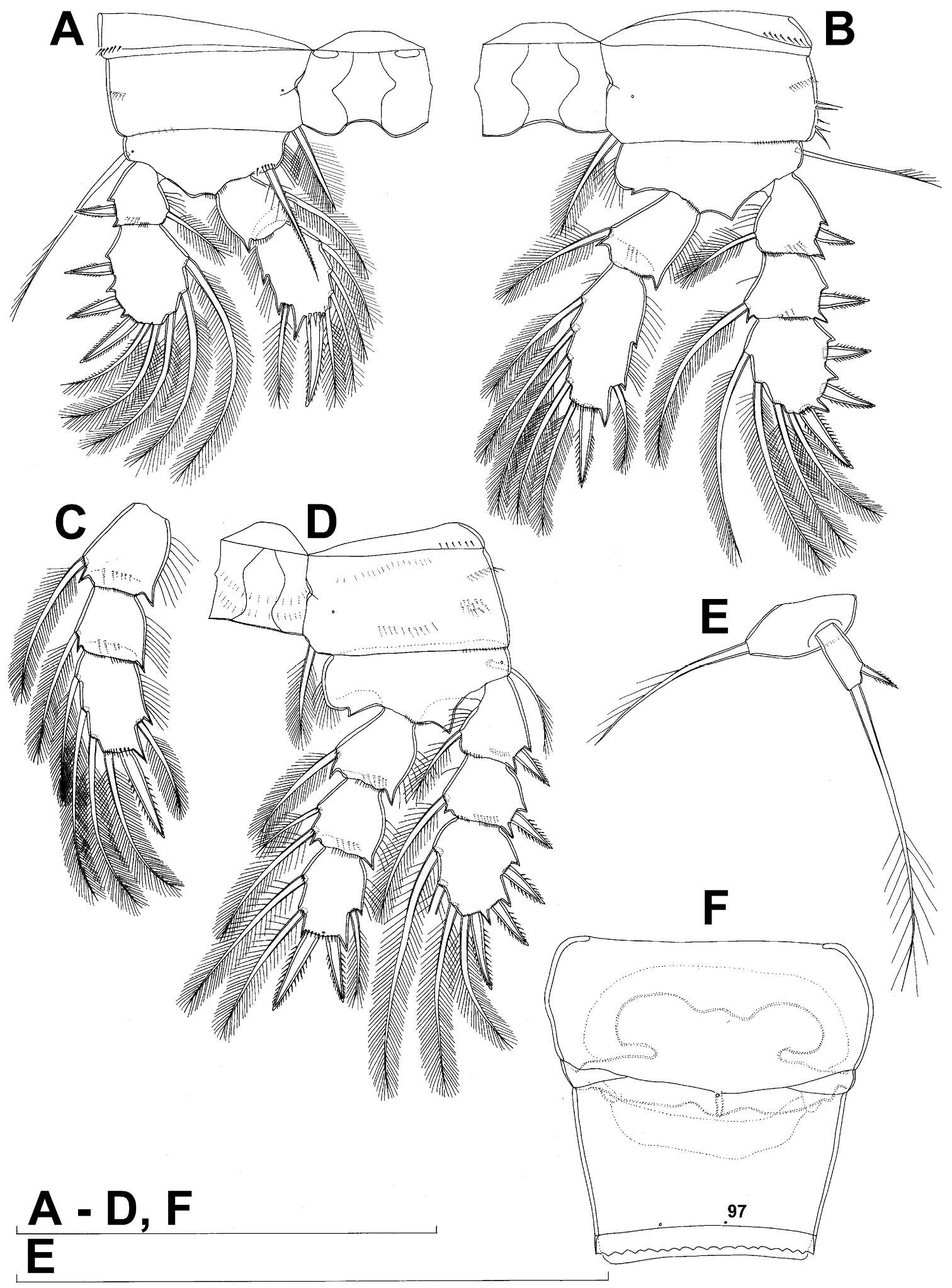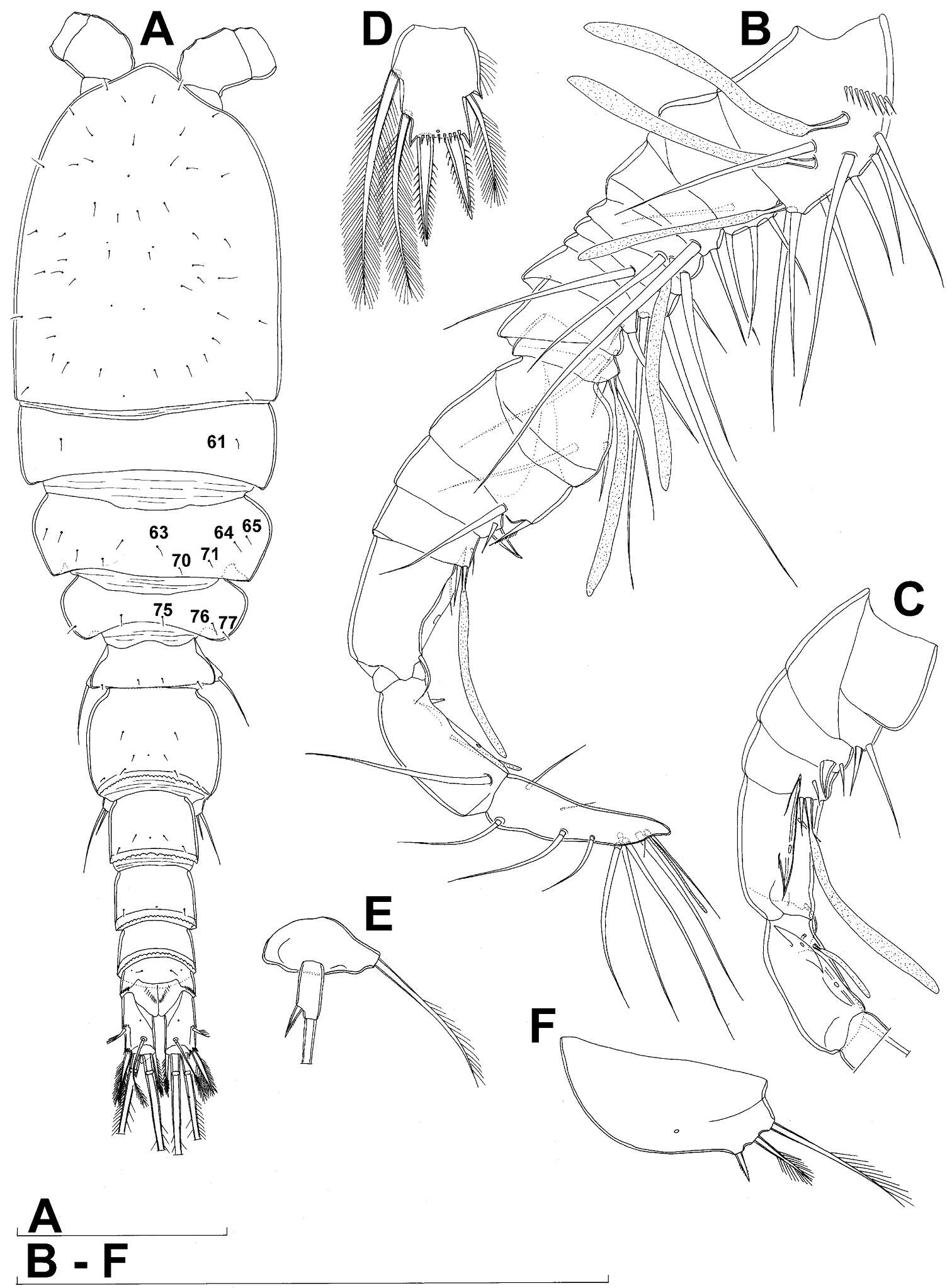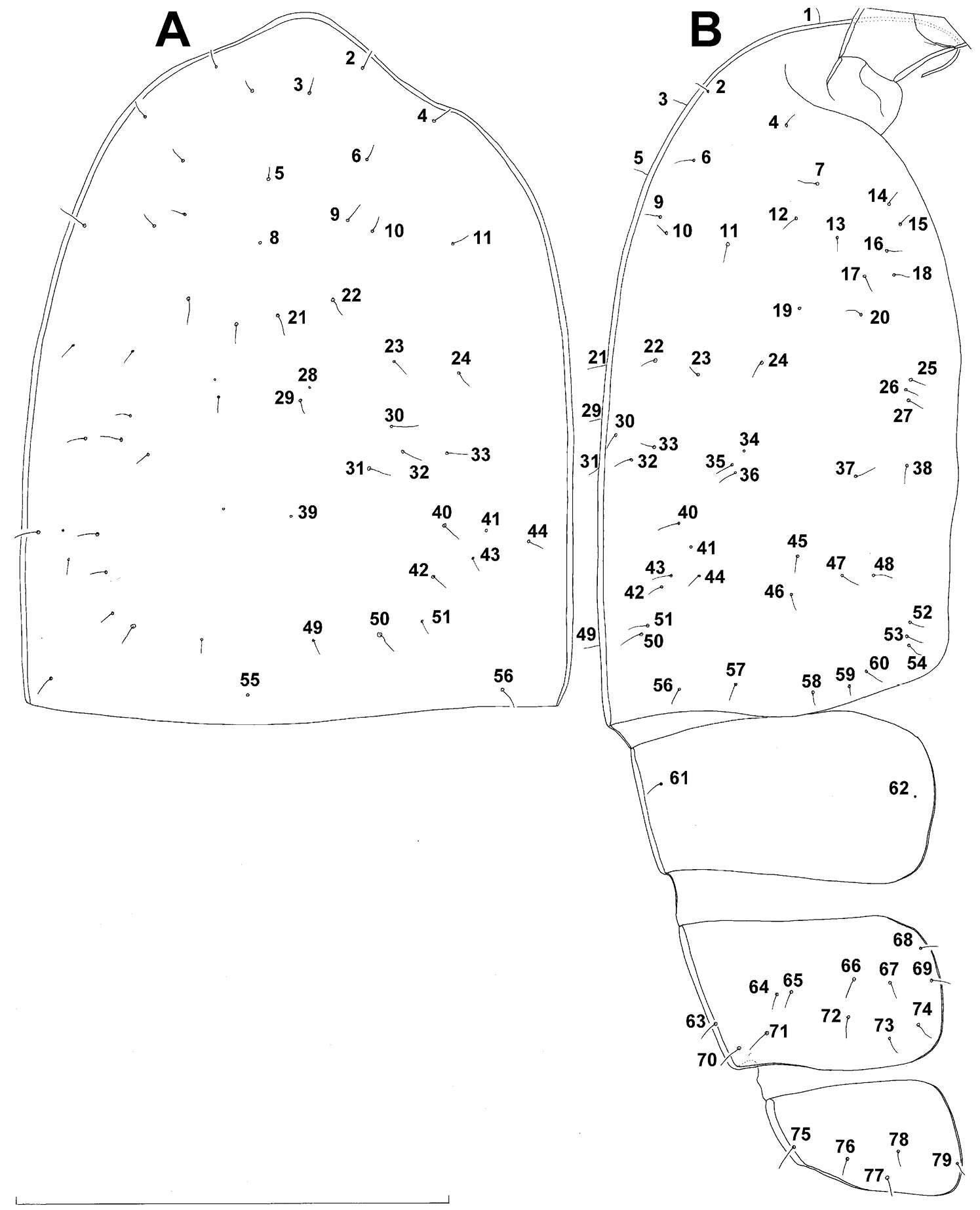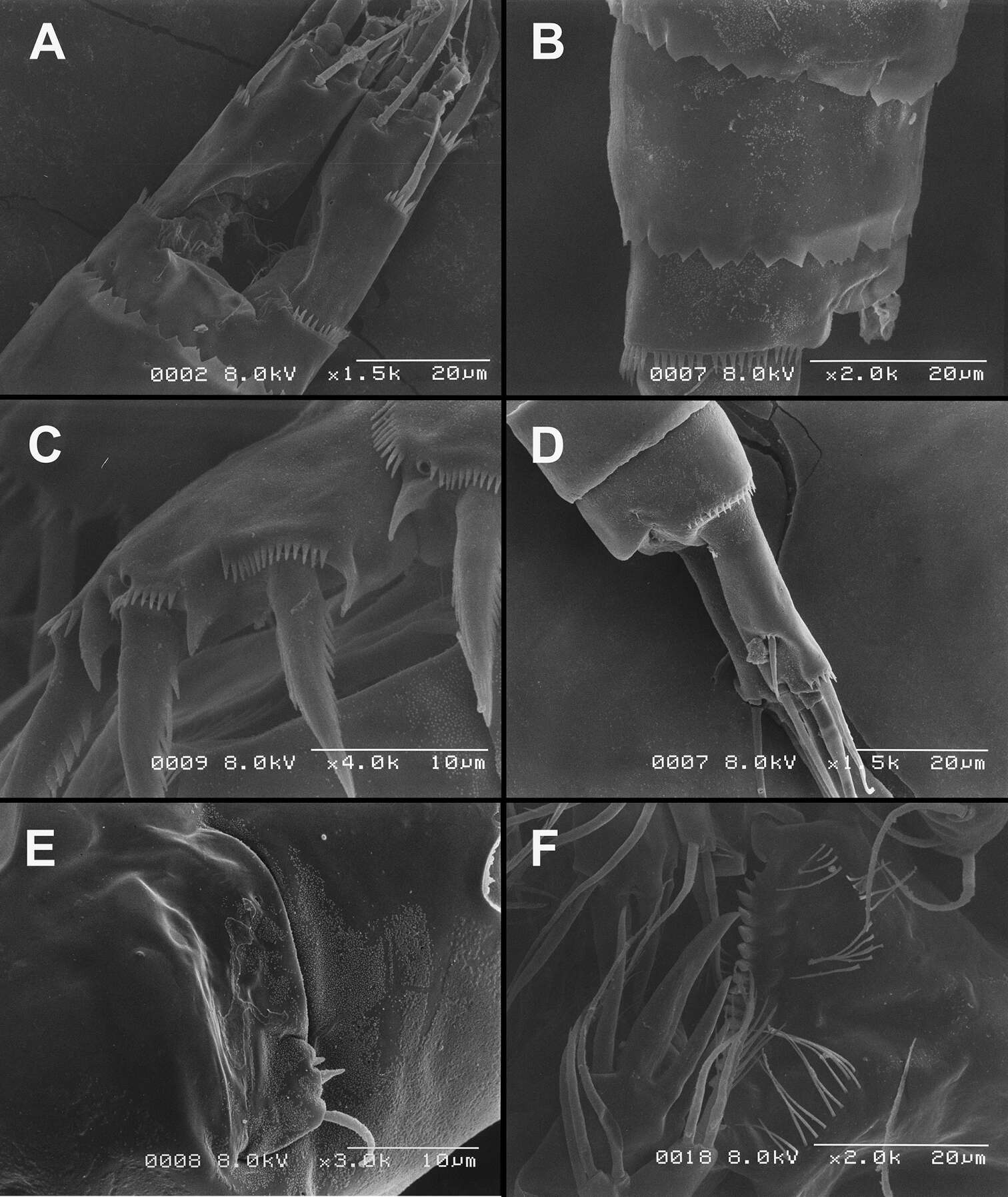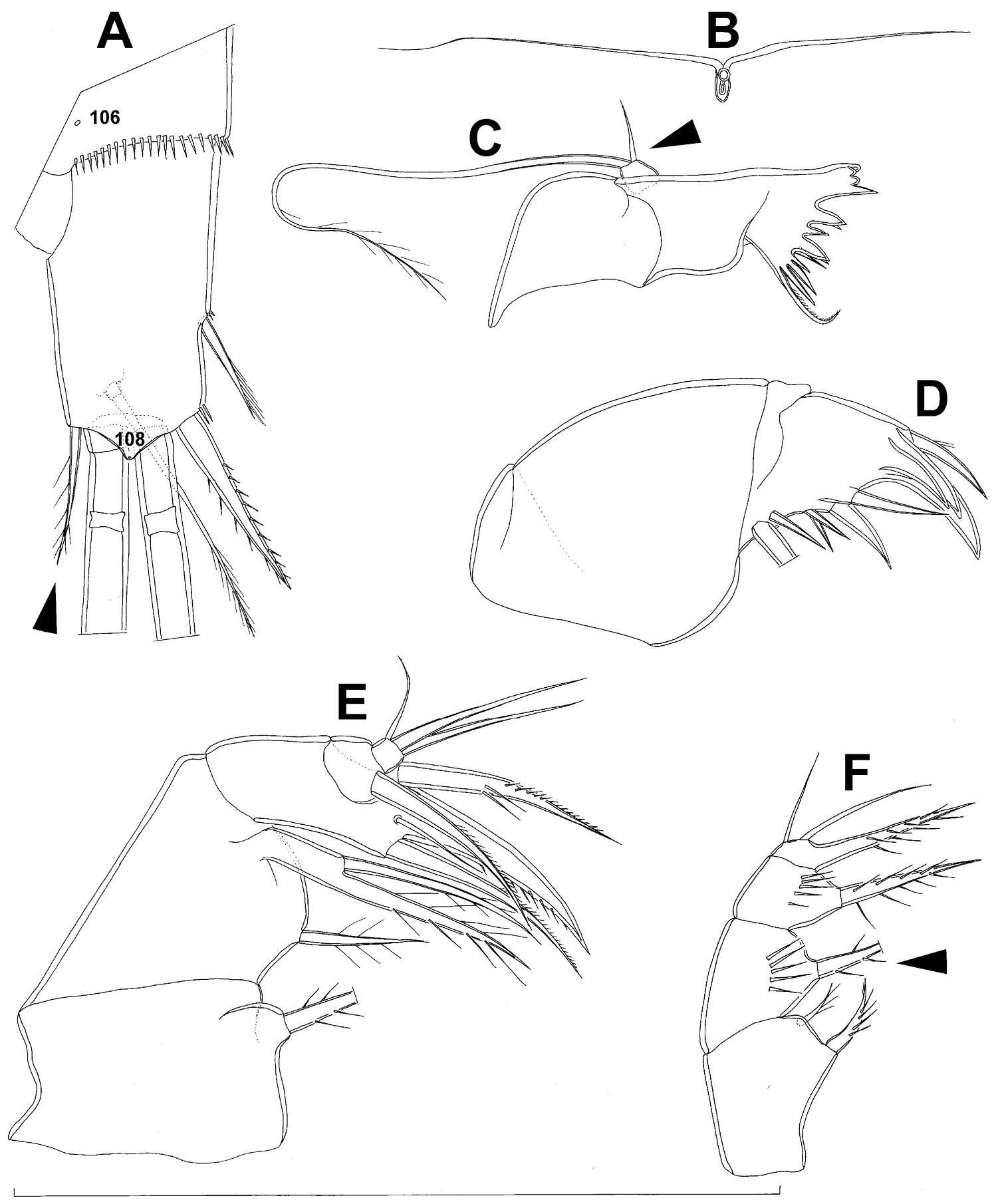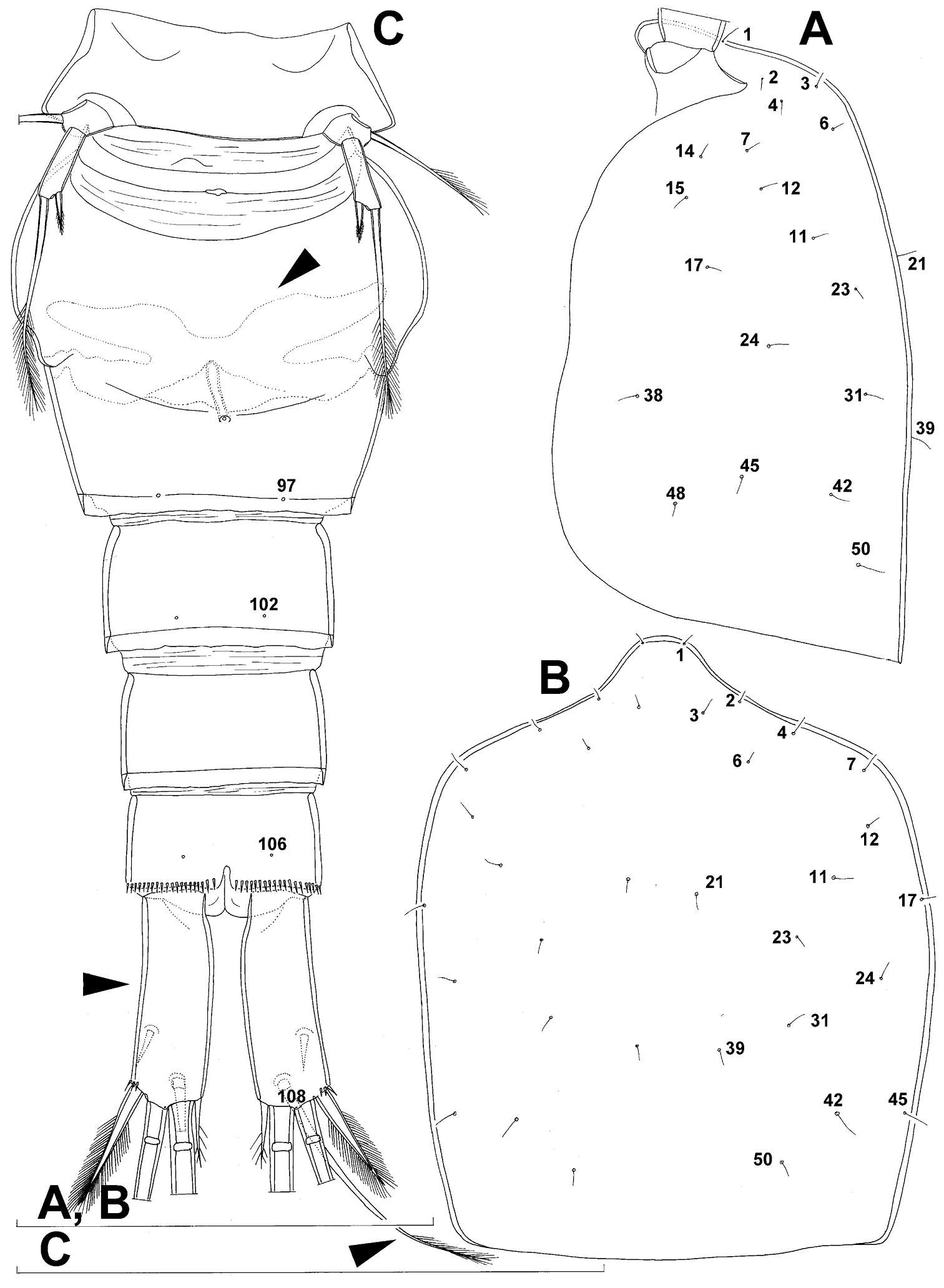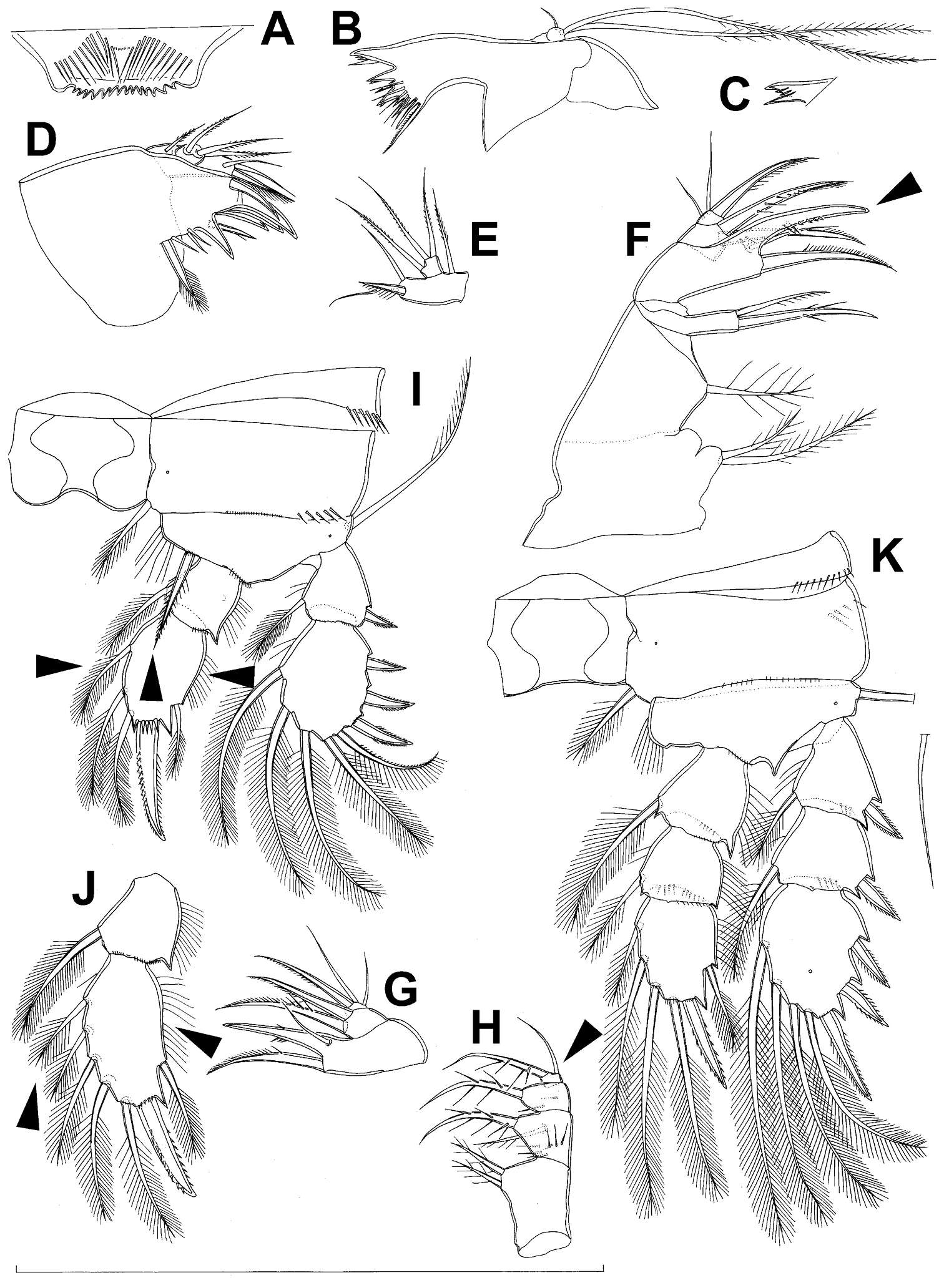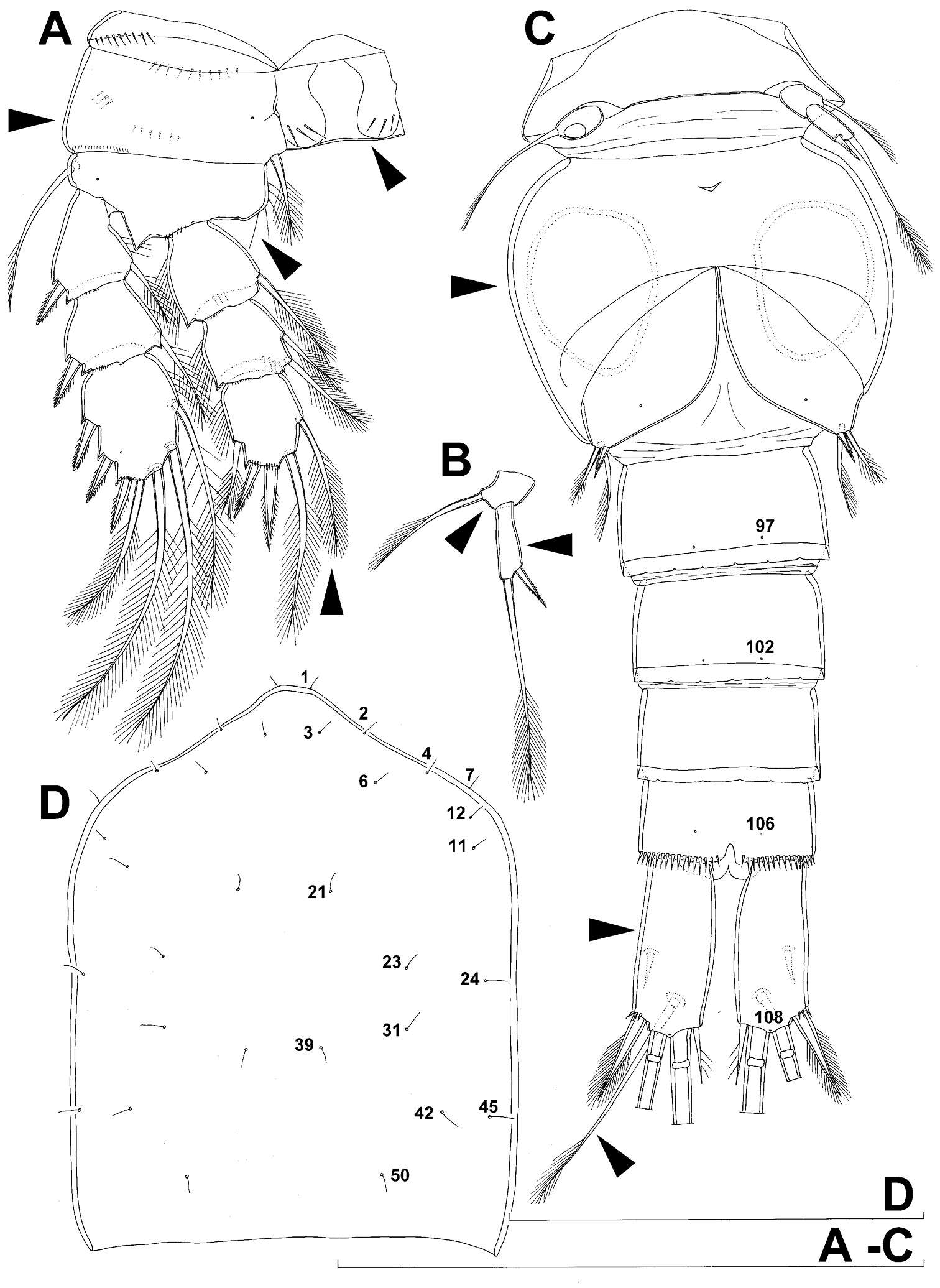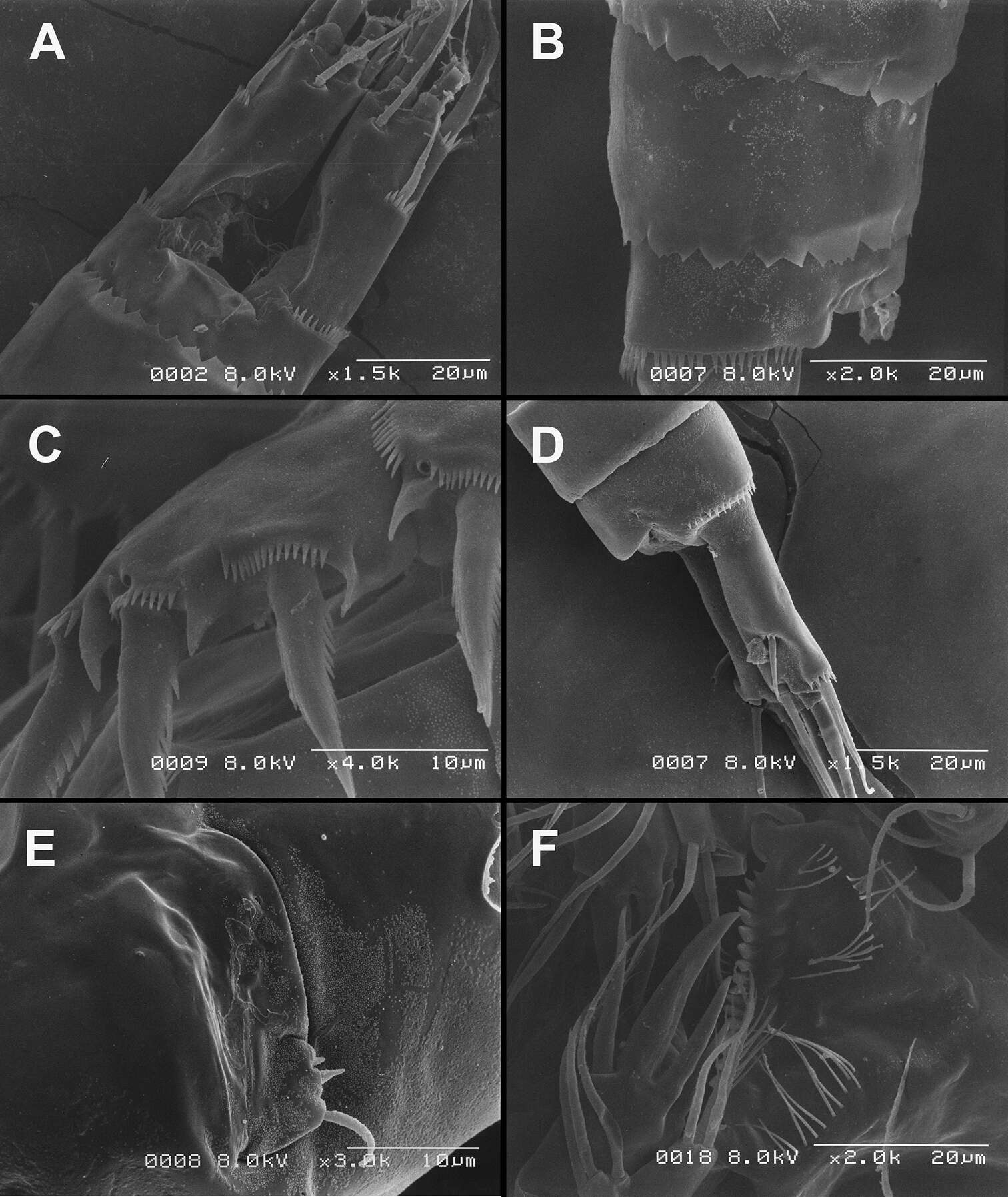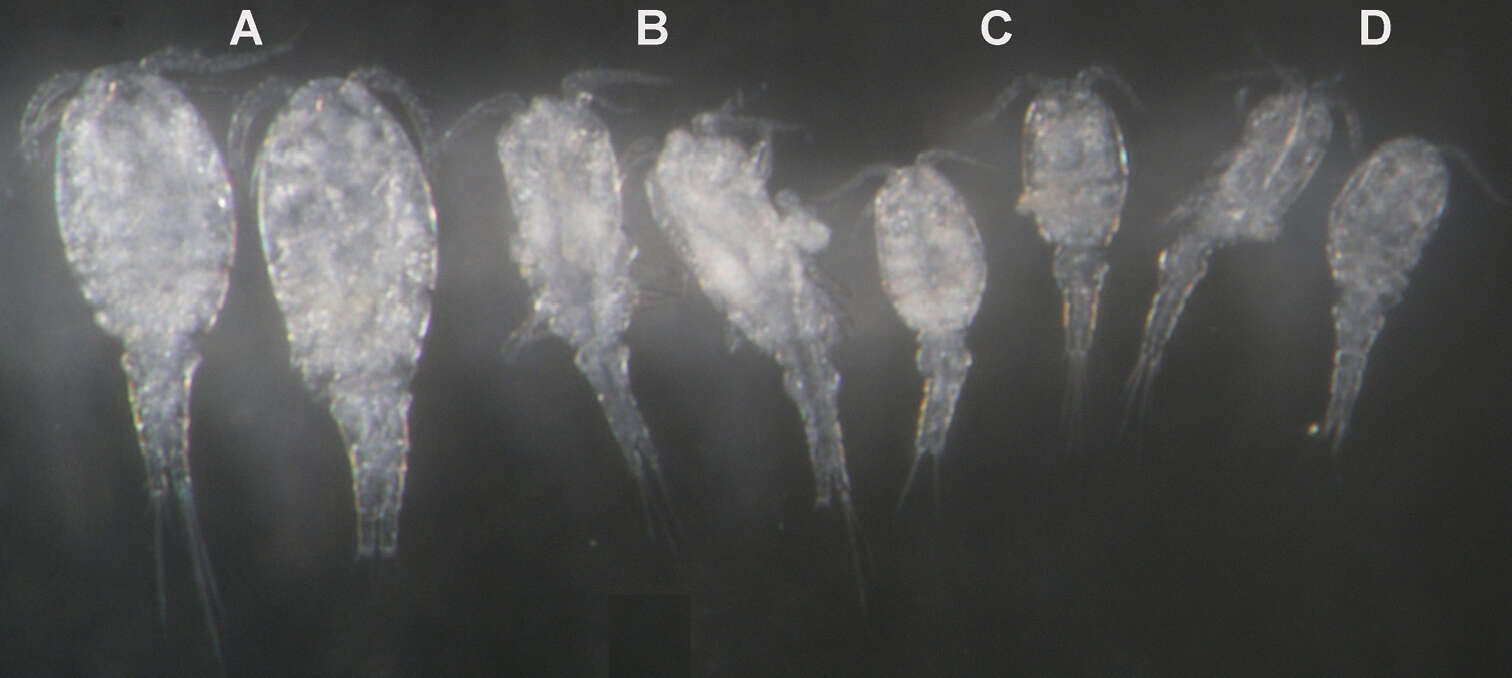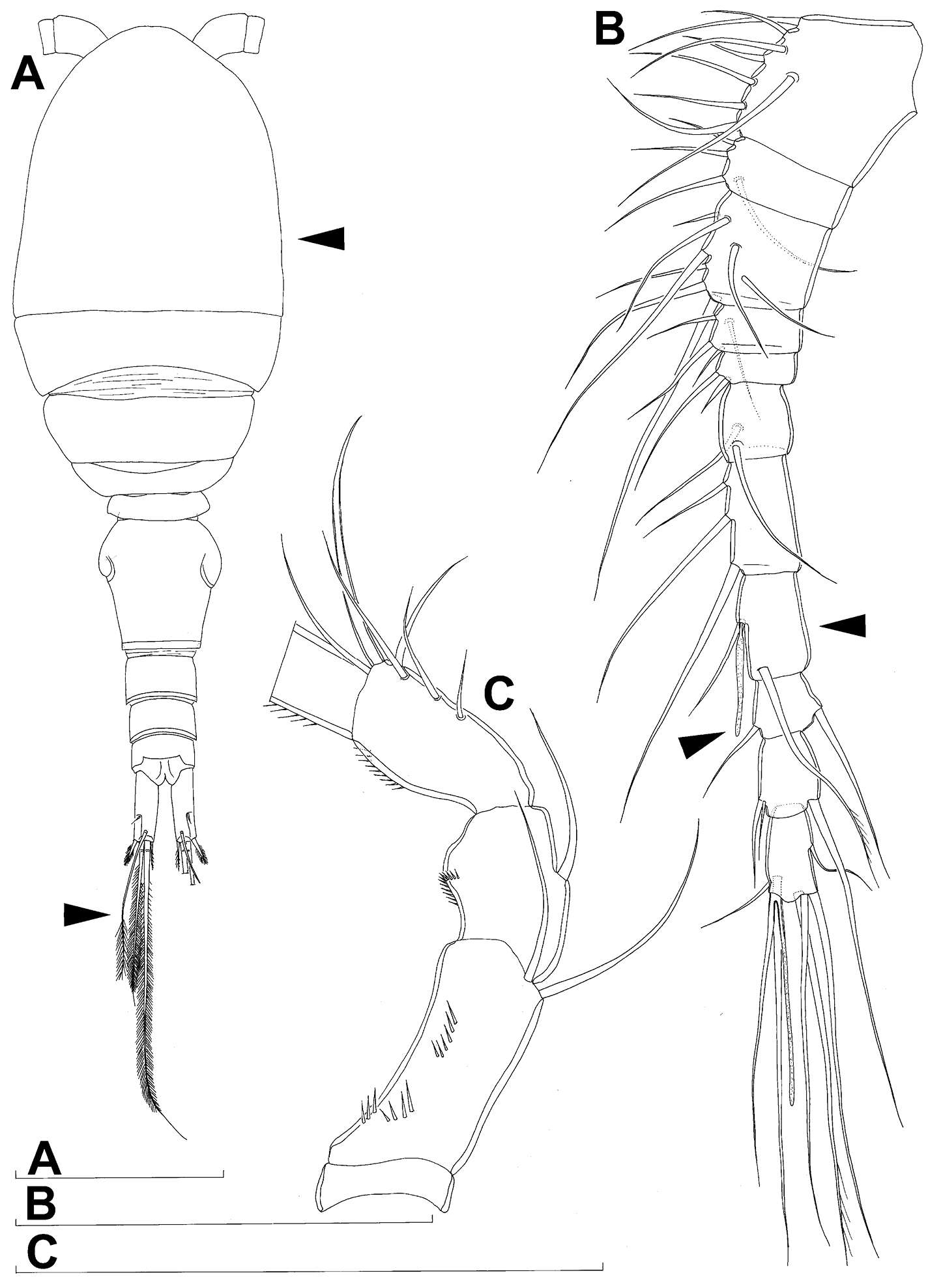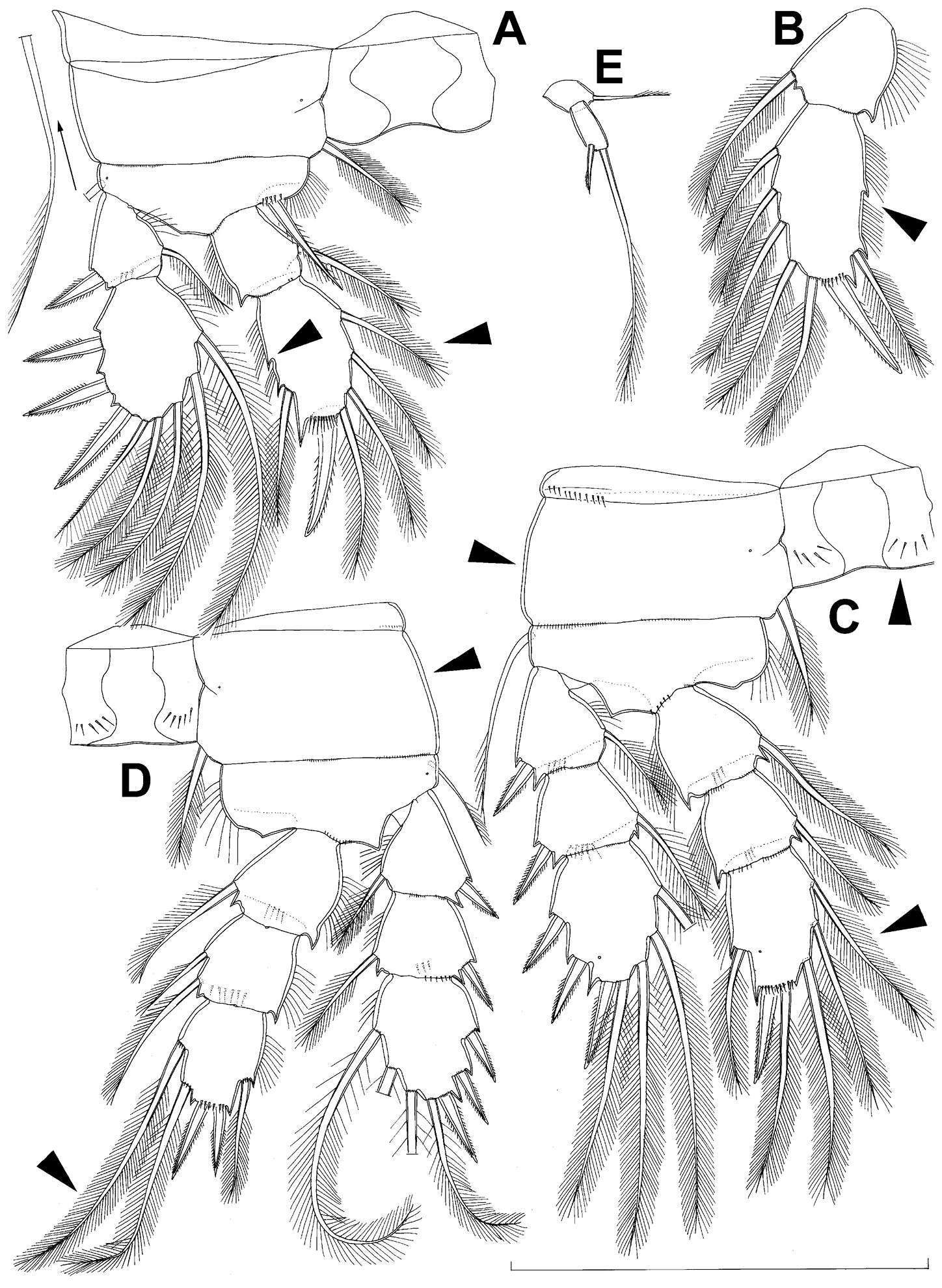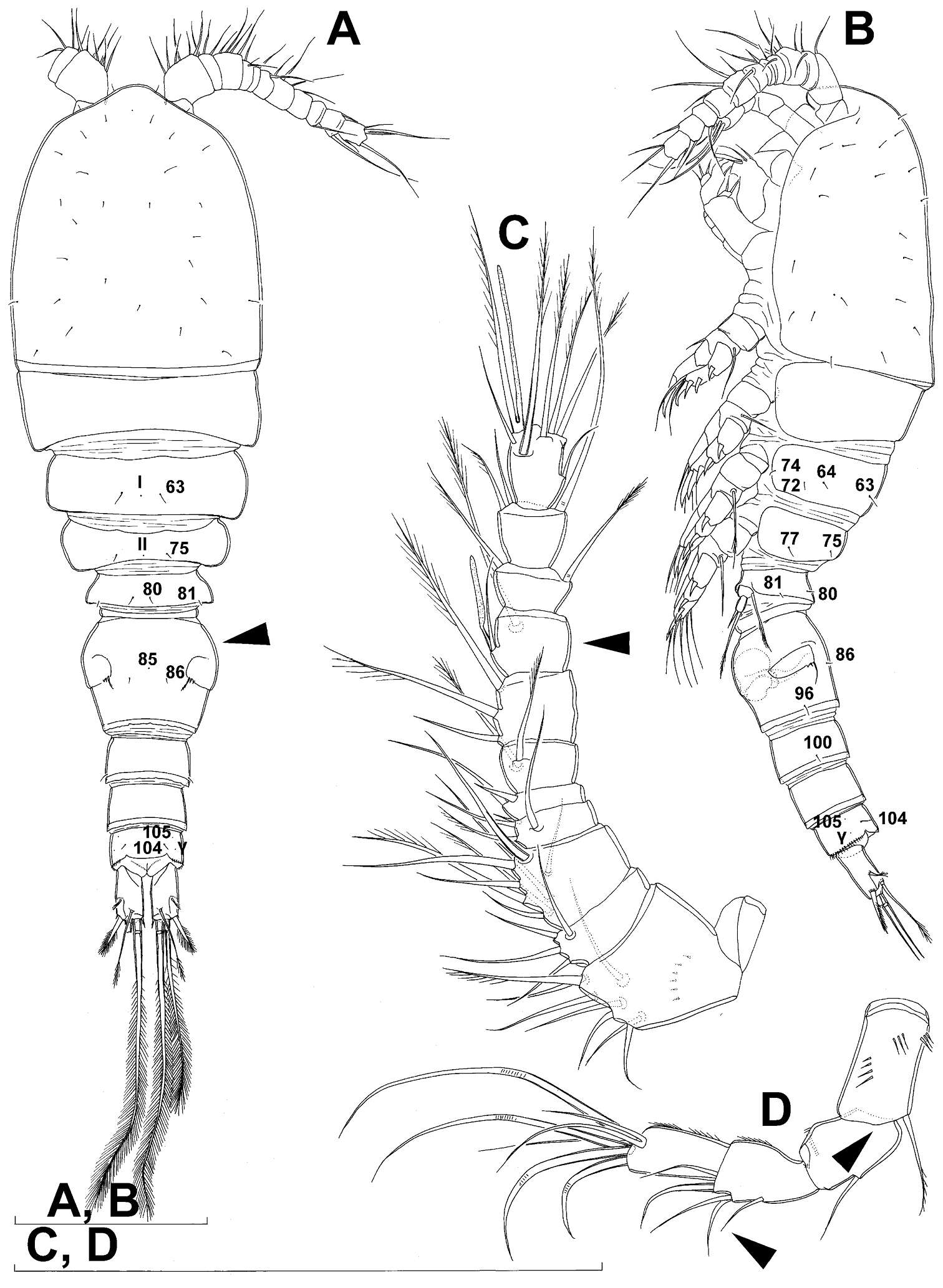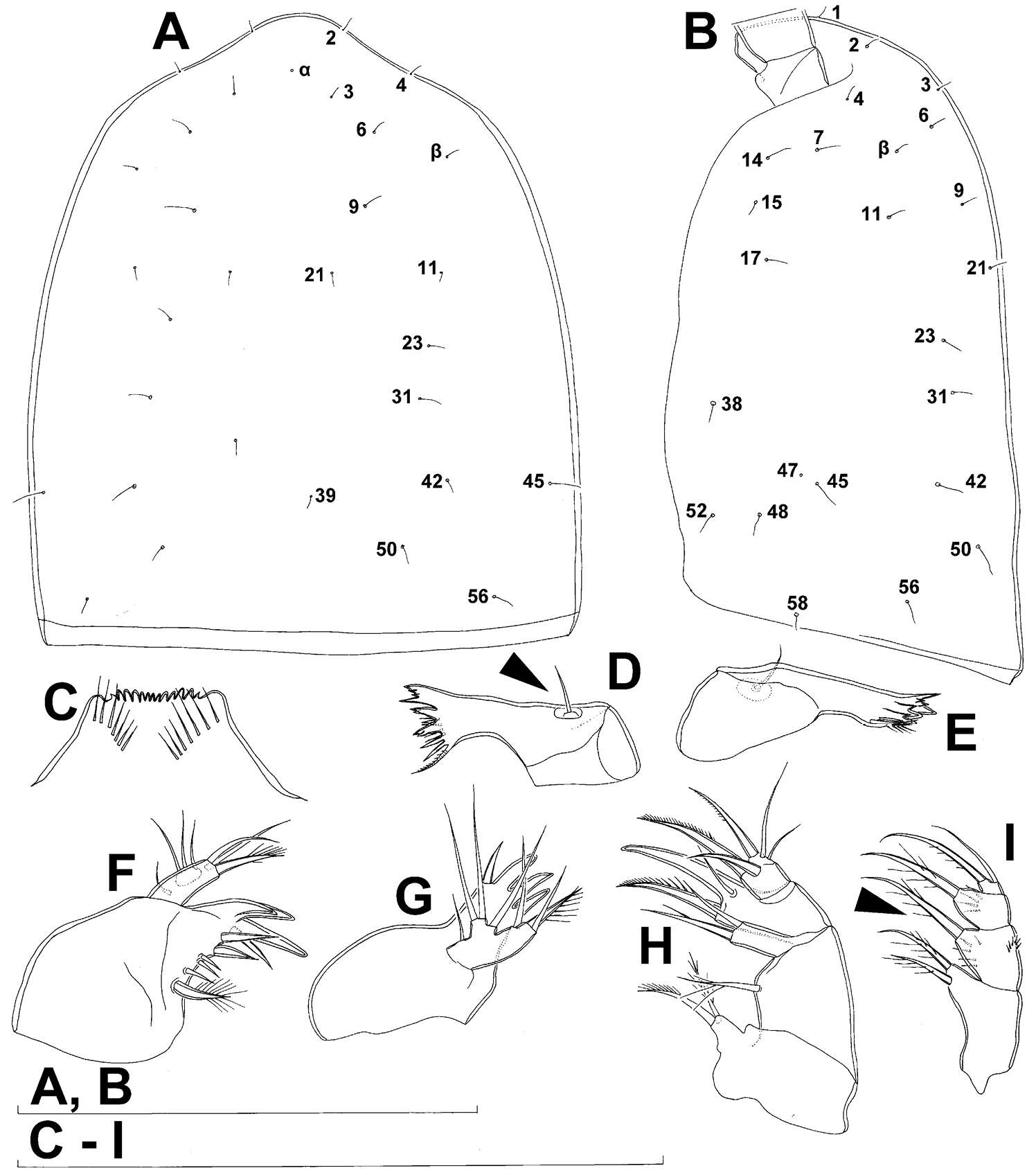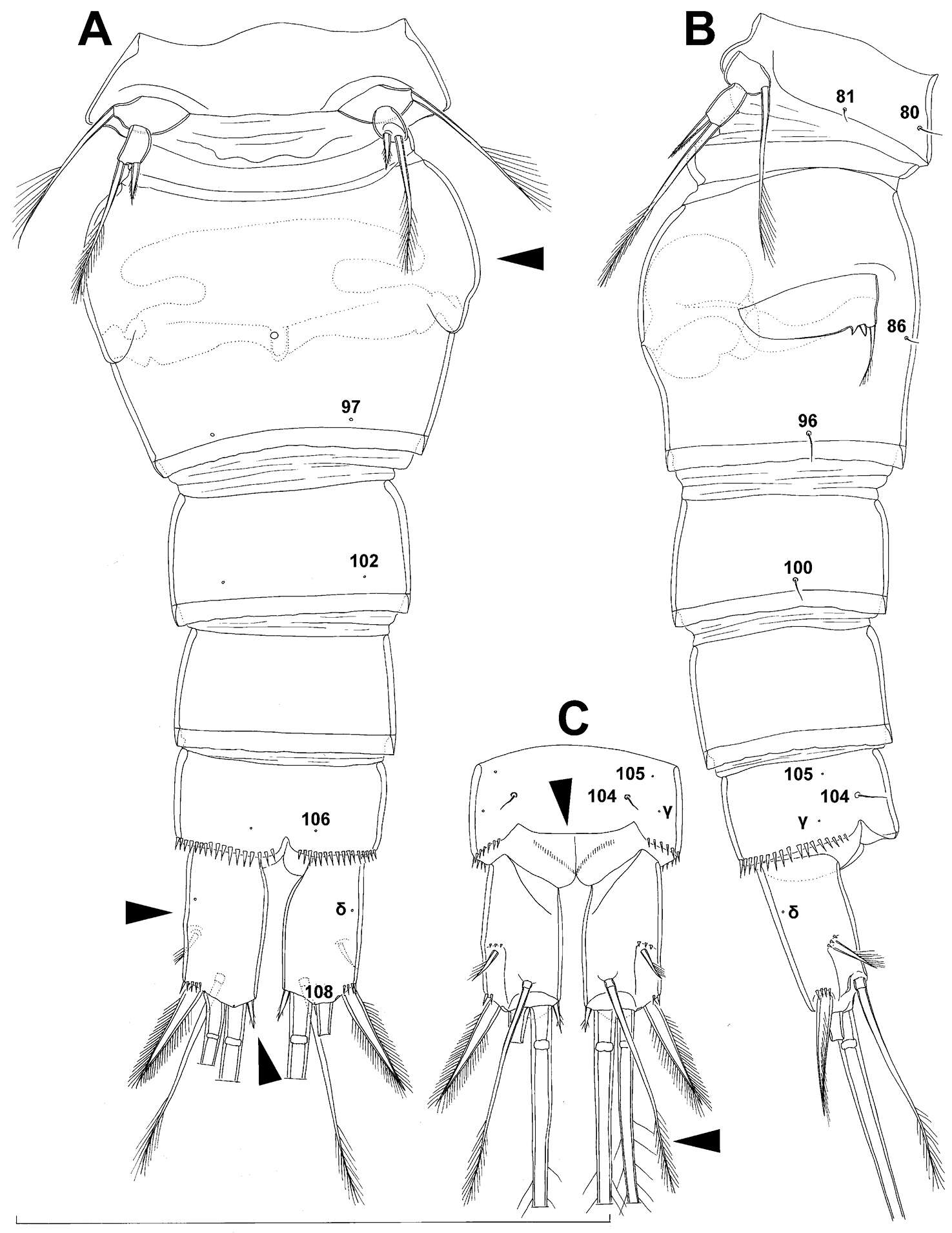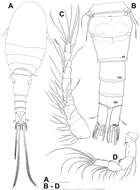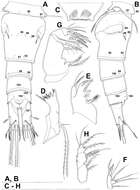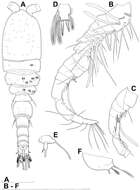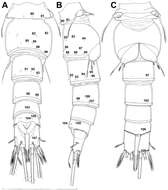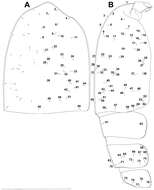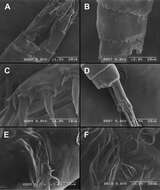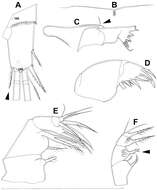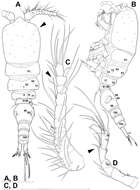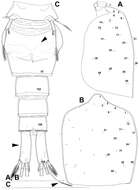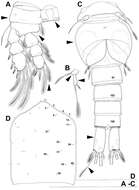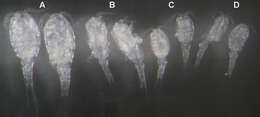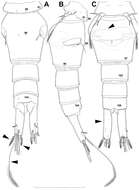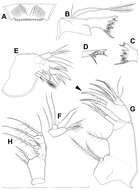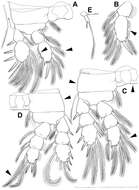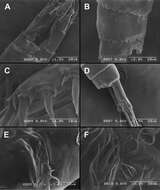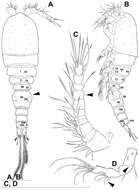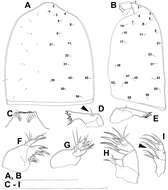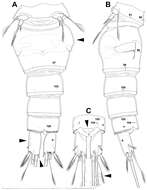-
Tomislav Karanovic, Mark J. Grygier, Wonchoel Lee
Zookeys
Figure 1.Diacyclops ishidai sp. n., holotype female: A habitus, dorsal view B urosome, ventral view C antennula, dorsal view D antenna, dorsal view. Arabic numerals numbering sensilla and pores consecutively from anterior to posterior end of body, and from dorsal to ventral side (excluding appendages). Scale bars 100 μm.
-
Tomislav Karanovic, Mark J. Grygier, Wonchoel Lee
Zookeys
Figure 2.Diacyclops ishidai sp. n., holotype female: A urosome, dorsal view B urosome, lateral view C labrum, anterior view D mandibula, anterior view E maxillula, posterior view (palp armature omitted) F maxillular palp, anterior view G maxilla, posterior view H maxilliped, anterior view. Arabic numerals numbering sensilla and pores consecutively from anterior to posterior end of body, and from dorsal to ventral side (excluding appendages). Scale bars 100 μm.
-
Tomislav Karanovic, Mark J. Grygier, Wonchoel Lee
Zookeys
Figure 3.Diacyclops ishidai sp. n., A–E holotype female F paratype female A first swimming leg, anterior view B second swimming leg, anterior view C endopod of third swimming leg, anterior view D fourth swimming leg, anterior view E fifth leg, anterior view F genital double-somite, ventral view. Arabic numerals numbering sensilla and pores consecutively from anterior to posterior end of body, and from dorsal to ventral side (excluding appendages). Scale bars 100 μm.
-
Tomislav Karanovic, Mark J. Grygier, Wonchoel Lee
Zookeys
Figure 4.Diacyclops ishidai sp. n., allotype male: A habitus, dorsal view B antennula, flattened and slightly uncoiled, ventral view C middle part of antennula, flattened and uncoiled, dorsal view D third endopodal segment of fourth swimming leg, anterior view E fifth leg, anterior view F sixth leg, ventro-lateral view. Arabic numerals numbering sensilla and pores consecutively from anterior to posterior end of body, and from dorsal to ventral side (excluding appendages). Scale bars 100 μm.
-
Tomislav Karanovic, Mark J. Grygier, Wonchoel Lee
Zookeys
Figure 5.Diacyclops ishidai sp. n., allotype male: A urosome, dorsal view B urosome, lateral view C urosome, ventral view. Arabic numerals numbering sensilla and pores consecutively from anterior to posterior end of body, and from dorsal to ventral side (excluding appendages). Scale bar 100 μm.
-
Tomislav Karanovic, Mark J. Grygier, Wonchoel Lee
Zookeys
Figure 6.Diacyclops ishidai sp. n., allotype male: A cephalothorax, dorsal view B cephalothoracic shield and pleurons of free prosomites, lateral view. Arabic numerals numbering sensilla and pores consecutively from anterior to posterior end of body, and from dorsal to ventral side (excluding appendages). Scale bar 100 μm.
-
Tomislav Karanovic, Mark J. Grygier, Wonchoel Lee
Zookeys
Figure 26.Scanning electron micrographs, A–C Diacyclops ishidai sp. n. D–E Diacyclops parasuoensis sp. n. F Diacyclops suoensis Ito, 1954: A anal somite and caudal rami, dorsal view, paratype female 1 B preanal and anal somites, lateral view, paratype female 2 C last two exopodal segments of second swimming legs, lateral view, paratype female 2 D anal somite and caudal rami, lateral view, paratype female E sixth leg, lateral view, paratype female F labrum and maxillulae, ventral view. Scale bars 20 μm (A, B, D, F) and 10 μm (C, E).
-
Tomislav Karanovic, Mark J. Grygier, Wonchoel Lee
Zookeys
Figure 7.Diacyclops brevifurcus Ishida, 2006, holotype female: A left caudal ramus, ventral view B copulatory pore, ventral view C mandibula, posterior view D maxillula, posterior view (palp broken off) E maxilla, anterior view F maxilliped, anterior view. Arabic numerals indicating sensilla and pores presumably homologous to those in Diacyclops ishidai sp. n. Arrows pointing most prominent specific features. Scale bar 100 μm.
-
Tomislav Karanovic, Mark J. Grygier, Wonchoel Lee
Zookeys
Figure 8.Diacyclops brevifurcus Ishida, 2006, holotype female: A third swimming leg, posterior view B fourth swimming leg, posterior view C fifth leg, anterior view. Arrows pointing most prominent specific features. Scale bars 100 μm.
-
Tomislav Karanovic, Mark J. Grygier, Wonchoel Lee
Zookeys
Figure 9.Diacyclops parasuoensis sp. n., holotype female: A habitus, dorsal view B habitus, lateral view C antennula, ventral view D antenna, dorsal view. Arabic numerals indicating sensilla and pores presumably homologous to those in Diacyclops ishidai sp. n. Roman numerals indicating pores not present in Diacyclops ishidai sp. n. Arrows pointing most prominent specific features. Scale bars 100 μm.
-
Tomislav Karanovic, Mark J. Grygier, Wonchoel Lee
Zookeys
Figure 10.Diacyclops parasuoensis sp. n., holotype female: A cephalothoracic shield, lateral view B cephalothorax, dorsal view C urosome, ventral view. Arabic numerals indicating sensilla and pores presumably homologous to those in Diacyclops ishidai sp. n. Arrows pointing most prominent specific features. Scale bars 100 μm.
-
Tomislav Karanovic, Mark J. Grygier, Wonchoel Lee
Zookeys
Figure 11.Diacyclops parasuoensis sp. n., holotype female: A labrum, anterior view B mandibula, anterior view C quadricuspidate ventralmost tooth of mandibula, posterior view D maxillula, posterior view E maxillular palp, anterior view F maxilla, anterior view G basis and endopod of maxilla, posterior view H maxilliped, posterior view I first swimming leg, anterior view J endopod of second swimming leg, anterior view K third swimming leg, anterior view. Arrows pointing most prominent specific features. Scale bar 100 μm.
-
Tomislav Karanovic, Mark J. Grygier, Wonchoel Lee
Zookeys
Figure 12.Diacyclops parasuoensis sp. n., A–B holotype female C–D allotype male. A fourth swimming leg, anterior view B fifth leg, anterior view C urosome, ventral view D cephalothorax, dorsal view. Arabic numerals indicating sensilla and pores presumably homologous to those in Diacyclops ishidai sp. n. Arrows pointing most prominent specific features. Scale bars 100 μm.
-
Tomislav Karanovic, Mark J. Grygier, Wonchoel Lee
Zookeys
Figure 13.Diacyclops parasuoensis sp. n., allotype male: A habitus, dorsal view B urosome, lateral view C antennula, flattened and slightly uncoiled, ventral view D sixth leg, ventro-lateral view. Arabic numerals indicating sensilla and pores presumably homologous to those in Diacyclops ishidai sp. n. Roman numerals indicating pores not present in Diacyclops ishidai sp. n. Arrows pointing most prominent specific features. Scale bars 100 μm.
-
Tomislav Karanovic, Mark J. Grygier, Wonchoel Lee
Zookeys
Figure 26.Scanning electron micrographs, A–C Diacyclops ishidai sp. n. D–E Diacyclops parasuoensis sp. n. F Diacyclops suoensis Ito, 1954: A anal somite and caudal rami, dorsal view, paratype female 1 B preanal and anal somites, lateral view, paratype female 2 C last two exopodal segments of second swimming legs, lateral view, paratype female 2 D anal somite and caudal rami, lateral view, paratype female E sixth leg, lateral view, paratype female F labrum and maxillulae, ventral view. Scale bars 20 μm (A, B, D, F) and 10 μm (C, E).
-
Tomislav Karanovic, Mark J. Grygier, Wonchoel Lee
Zookeys
Figure 27.Light photograph of four sympatric Korean species of the Diacyclops/Acanthocyclops complex from Seomjin River: A Acanthocyclops sensitivus (Graeter & Chappuis, 1914), two adult females B Diacyclops languidoides s.l. (Lilljeborg, 1901), two adult females C Diacyclops parasuoensis sp. n., two adult females D Diacyclops hanguk sp. n., two adult females.
-
Tomislav Karanovic, Mark J. Grygier, Wonchoel Lee
Zookeys
Figure 14.Diacyclops suoensis Ito, 1954, female: A habitus, dorsal view B antennula, ventral view C antenna, ventral view. Arrows pointing most prominent specific features. Scale bars 100 μm.
-
Tomislav Karanovic, Mark J. Grygier, Wonchoel Lee
Zookeys
Figure 15.Diacyclops suoensis Ito, 1954, female: A urosome, dorsal view B urosome, lateral view C urosome, ventral view. Arabic numerals indicating sensilla and pores presumably homologous to those in Diacyclops ishidai sp. n. Arrows pointing most prominent specific features. Scale bar 100 μm.
-
Tomislav Karanovic, Mark J. Grygier, Wonchoel Lee
Zookeys
Figure 16.Diacyclops suoensis Ito, 1954, female: A labrum, anterior view B mandibula, anterior view C cutting edge of mandibula, posterior view D cutting edge of mandibula, dorsal view E maxillula, posterior view F maxillular palp, posterior view G maxilla, anterior view H maxilliped, anterior view. Arrows pointing most prominent specific features. Scale bar 100 μm.
-
Tomislav Karanovic, Mark J. Grygier, Wonchoel Lee
Zookeys
Figure 17.Diacyclops suoensis Ito, 1954, female: A first swimming leg, anterior view B endopod of second swimming leg, anterior view C third swimming leg, anterior view D fourth swimming leg, anterior view E fifth leg, anterior view. Arrows pointing most prominent specific features. Scale bar 100 μm.
-
Tomislav Karanovic, Mark J. Grygier, Wonchoel Lee
Zookeys
Figure 26.Scanning electron micrographs, A–C Diacyclops ishidai sp. n. D–E Diacyclops parasuoensis sp. n. F Diacyclops suoensis Ito, 1954: A anal somite and caudal rami, dorsal view, paratype female 1 B preanal and anal somites, lateral view, paratype female 2 C last two exopodal segments of second swimming legs, lateral view, paratype female 2 D anal somite and caudal rami, lateral view, paratype female E sixth leg, lateral view, paratype female F labrum and maxillulae, ventral view. Scale bars 20 μm (A, B, D, F) and 10 μm (C, E).
-
Tomislav Karanovic, Mark J. Grygier, Wonchoel Lee
Zookeys
Figure 18.Diacyclops hanguk sp. n., holotype female: A habitus, dorsal view B habitus, lateral view C antennula, dorsal view D antenna, ventral view. Arabic numerals indicating sensilla and pores presumably homologous to those in Diacyclops ishidai sp. n. Roman numerals indicating pores homologous to those in Diacyclops parasuoensis sp. n. Arrows pointing most prominent specific features. Scale bars 100 μm.
-
Tomislav Karanovic, Mark J. Grygier, Wonchoel Lee
Zookeys
Figure 19.Diacyclops hanguk sp. n., holotype female: A cephalothorax, dorsal view B cephalothoracic shield, lateral view C labrum, anterior view D mandibula, posterior view E mandibula, antero-ventral view F maxillula, posterior view G maxillula, anterior view H maxilla, posterior view I maxilliped, posterior view. Arabic numerals indicating sensilla and pores presumably homologous to those in Diacyclops ishidai sp. n. Greek letters indicating unique pores and sensilla. Arrows pointing most prominent specific features. Scale bars 100 μm.
-
Tomislav Karanovic, Mark J. Grygier, Wonchoel Lee
Zookeys
Figure 20.Diacyclops hanguk sp. n., holotype female: A urosome, ventral view B usorome, lateral view C anal somite and caudal rami, dorsal view. Arabic numerals indicating sensilla and pores presumably homologous to those in Diacyclops ishidai sp. n. Greek letters indicating unique pores and sensilla. Arrows pointing most prominent specific features. Scale bar 100 μm.

